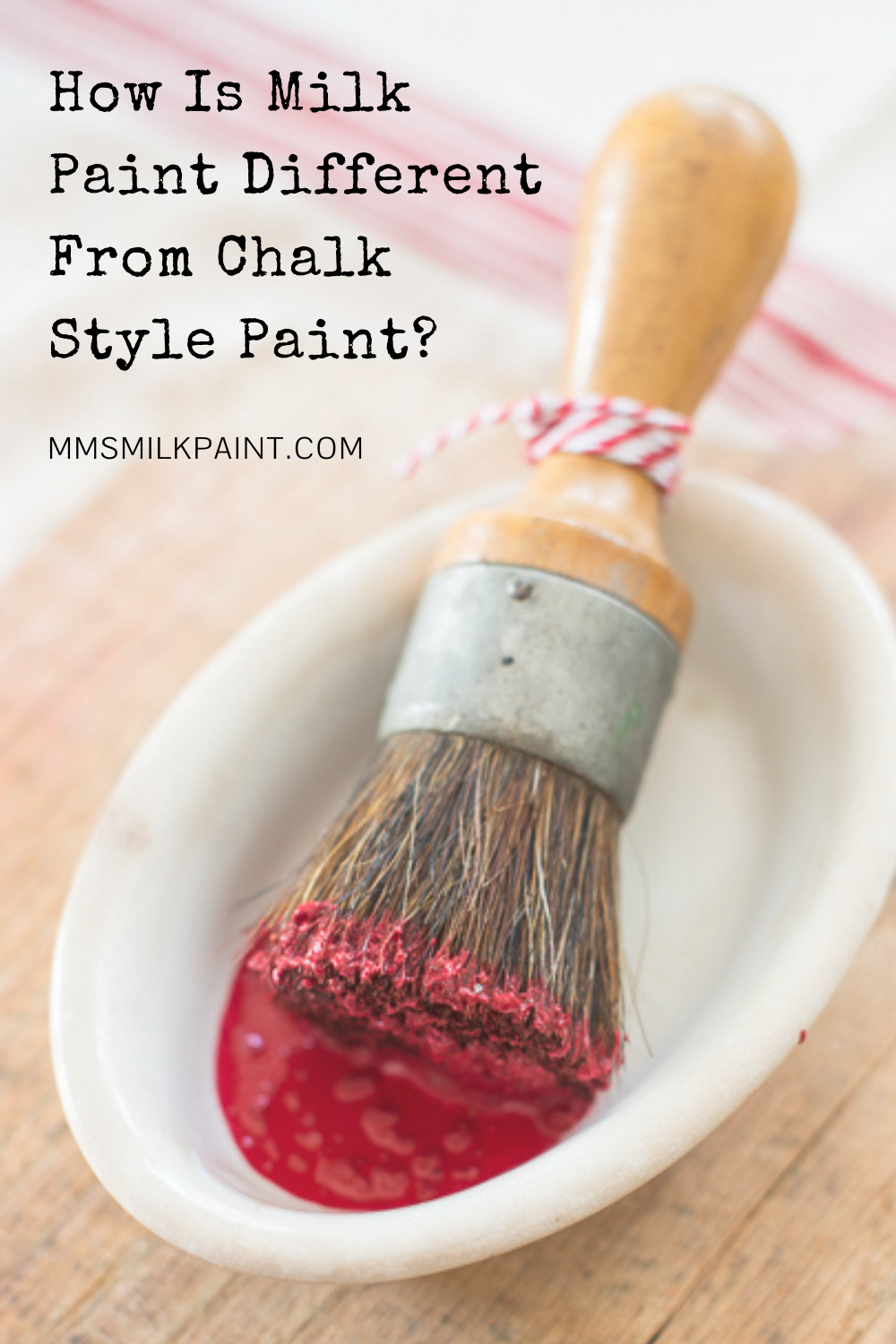Milk Paint vs. Chalk Style Paint
What is the difference between milk paint and chalk-style paint?
Aside from “What is Milk Paint,” this is the second most frequently asked question we (and our retailers) receive!
The words milk paint and chalk-style paint are often used interchangeably and lumped together in the same category. While they do share a few similarities, they are quite different.
Let’s take a closer look at milk paint and chalk-style paint.
How are MMS Milk Paint and Chalk Style Paint Sold?
Miss Mustard Seed's Milk Paint, is sold in powdered form.When you want to use milk paint, you simply mix it with water. This form allows for extended shelf life for milk paint powder. Please note, when milk paint is mixed, the shelf life is limited. Our MilkPaint™ formula can last for up to two weeks when covered and stored in a cool area, like the refrigerator. Our formula contains simple pronounceable ingredients including casein (milk protein) which puts the MILK in milk paint! We proudly offer our MilkPaint™ in pouches with zip loc-style closures.
The phrase “Chalk Paint®” is actually a trademarked brand of paint by Annie Sloan. Other companies have paints that give you a chalky finish. These are referred to as “chalk style,” “chalk finish,” or “chalk mineral” paints. This type of paint is usually sold in cans or plastic jars, comes in liquid form, and is pre-mixed.
Both chalk-style paint and MMS MilkPaint™ give you a gorgeous and desirable matte, flat, no-shine finish.
Prepping Your Project for MMS MilkPaint™ and Chalk Style Paint
Here’s how you prep to use MMS MilkPaint™:
Raw Wood - No prep is required. MMS MilkPaint™ will soak into raw wood like a stain.
Pre-Finished Surfaces - Scuff up the surface with medium grit sandpaper (100-150) prior to painting. Remove the dust with a vacuum. If you want the chippy look, do a light scuff sanding. If you don’t, go a bit heavier on the scuffing and mix MilkGrip™ into your MilkPaint™.
Glass & Metal - Clean the surface with either Windex or a slightly dampened rag. Obviously, you can’t sand these surfaces, so mix up your MilkPaint™, add MilkGrip™ and have fun!
Prepping for chalk styles of paint is relatively simple - a quick wipe-down is all that is needed. Prep sanding is usually not required.
Do Milk Paint and Chalk Style Paint Require a Primer?
There are a few reasons why you would want to use a primer. Let’s take a look at the two main reasons.
Reason 1 - To Improve Adhesion
A primer is not necessary with MMS MilkPaint™ to improve its adhesive properties. Simply use our MilkGrip™ Indoor/Bonding Agent.
The nice thing about MilkGrip™ Bonding Agent is that it's not a separate primer - it's an additive you squirt into mixed MilkPaint™, so it's still a one-step process.
Chalk styles of paint are usually pretty “grippy” and don’t require any help to stick to surfaces.
Reason 2 - To Prevent Staining, Yellowing, and Wood Tannin Bleed-Through
This is a great reason to use a primer with ANY type of paint! Sometimes, stains can wiggle their way through your paint (no matter what kind it is) and wreak havoc on your finish. The same goes for wood tannins (aka wood oils). You’ve probably seen this when pine wood has been painted white, and the tan rings of knots begin to show through. Or you painted a table white, and you notice little pink spots start to develop. No matter how many coats of paint you apply, they won’t go away.
Some brands of paint will say that you don’t need a primer, but it’s always a good idea when:
going from very dark wood to a very light color of paint
painting over certain species of wood such as mahogany, strongly-grained oak, rosewood, or knotty pine
using any shade of white
painting a light color on a piece that has an existing red, orange, or dark brown stain
There are always exceptions to the rule. You might be able to paint a piece with the conditions mentioned above without a primer and be fine. Many of our customers and retailers have had great success using our light shades of paint without the need for a stain-blocking primer. Eventually, though, one is going to come along that may give you a run for your money. Primer is still a good product to have on hand when a project gets a bit unruly.
Do You Need a Topcoat When Using Milk Paint or Chalk Style Paint?
The short answer is yes.
Next topic…Just kidding!
MMS Milk Paint and chalk-style paint are porous. They absorb water, oils, and stains if left unsealed, so it’s a good idea to apply a protective topcoat.
In the MMS Milk Paint line, we offer a variety of finishes MilkCoat™, MilkOil™ and multiple MilkWax™ finishes.
Chalk style paints often have polyurethane and wax finishing options as well.
How Do You Apply Each Style of Paint?
Both MMS MilkPaint™ and chalk-style paint can be applied with a brush, roller, or sprayer. If you opt for spraying, chalk-style paint may need to be thinned. MMS MilkPaint™ is thin, to begin with, and it needs to be well-mixed and strained before loading into a sprayer.
Do Milk Paint and Chalk Style Paint Produce Brushstrokes?
Ah yes, brushstrokes can be a bit of a pain to deal with if you’re aiming for a silky-smooth finish. Luckily, you don’t have to worry about those when you use MMS MilkPaint™!
Our paint soaks into the surface and behaves similar to a stain. It’s self-leveling and does not produce any brushstrokes! This makes it an ideal paint for a beginner to use because it’s incredibly forgiving.
Chalk style paints often produce brushstrokes due to their thick consistency. These can be smooth sanded but will typically not be as smooth to the touch as milk paint.
Can Chalk Style Paints do the “Chippy” Look?
MMS MilkPaint™ is famous for being able to naturally produce the “chippy” look due to its simple formula and tendency to flake away from shiny surfaces.
This effect is one you can only get naturally with Milk Paint without using a lot of extra additives on your project. It creates an authentically aged finish that looks like it’s been there for over 100 years!
It’s a bit harder for chalk style paint to do an authentic chippy look. It usually requires using resists like vaseline or wax. Typically, chalk style paint distresses in a fine powder and results in a more opaque full-coverage finish.
Summary
Overall, Miss Mustard Seed’s Milk Paint is incredibly versatile and can be mixed to any consistency. This allows the user to produce stains, opaque finishes and the chippy look. It’s completely customizable, allowing you to decide what it needs to be to suit your needs. Miss Mustard Seed’s Milk Paint soaks into your piece much like a stain and does not produce brush strokes. Milk Paint tends to chip and flake off from shiny factory-finished surfaces, requiring a bit more prep sanding and perhaps the use of our Bonding Agent. It dries to a matte finish with a chalky feel, providing you with an authentically aged finish. While the mixing stage can seem intimidating, the process is as familiar as mixing your morning protein shake or making brownies from a box! If you can stir, you can mix Milk Paint!
Chalk style paint has a lot more fillers and additives that make it smooth and creamy. It is more of an open-the-can-and-go product. While some chalk style paint brands promote a “no-prep needed” policy, you may need to apply primer or at least clean your piece prior to painting. Chalk style paint does not produce the chippy look easily and is known for having a more opaque full-coverage finish. It adheres very well on slick and shiny surfaces without the need for an extra bonding product. Typically it has a much thicker consistency than Miss Mustard Seed’s Milk Paint, and produces more brush strokes. These can be smooth sanded with a bit of effort.
Both styles of paint are fabulous choices. One is not better than the other. They offer the painter very different experiences and a variety of beautiful outcomes.
If you have more questions about Milk Paint, our talented retailers are ready to serve! Find one near you by visiting our map. Our social media channels are also excellent resources for help and inspiration. Tweet at us, send a Facebook Message or DM us on Instagram!










